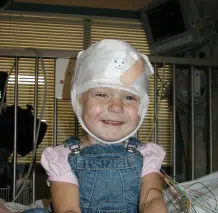After years of being frustrated with medications that failed to help her daughter Virginia, Kate was determined that research had to be the key to a cure for epilepsy. For more than a decade, Kate has supported CURE Epilepsy every year, whether running a 24-hour race, participating in our virtual event, or making a year-end gift.
We went to several hospitals, had several tests done, and whatever they tried didn’t work. So we’d gear up to go somewhere new and transfer all of Virginia’s medical records to a new place — once again full of hope — only to be told that there’s nothing they can do, even after trying many, many different medications; I lost count after eight. In an attempt to pinpoint the location of her seizures, the doctors even tried implanting electrodes into her brain, but that didn’t work. Her doctors said deep brain stimulation was the best they could do for Virginia. I knew that wouldn’t stop the seizures, only reduce the risk of death, and my gut told me there had to be something better out there. So I kept looking.
Despite hearing discouraging information about the difficulty of the ketogenic diet, I knew it was even more difficult not to try everything I could for Virginia. The diet actually provided her with some limited reprieve from her seizures, but ultimately they came back. I wish I had done it years earlier because, when combined with the right medications, research suggests that the younger the patient is, the more likely the ketogenic diet will work. Finally, and thanks to my network of CURE Epilepsy friends, I found Dr. M. Scott Perry at Cook Children’s Hospital in Texas. We went to visit, and after one night of observations, the staff there informed me that ‘we can help her.’ They enrolled Virginia in a new research study that combined another diagnostic surgery with advanced brain imaging techniques. Through this combination, the team was able to do what no other doctors could do before: pinpoint exactly where the seizures were coming from. With that information, they could do a minimally invasive laser ablation. She was discharged from the hospital after surgery and hasn’t had another seizure.
For years and years, we were told that surgery was not an option for Virginia. Surgery sounds like such a big deal and there’s so much misinformation in the media. We have a ton of educating to do about how safe and non-invasive surgery can be, especially for small children. The combination of advanced imaging tools and electroencephalography options will allow us to find that more people are surgical candidates much sooner. We need to move people with epilepsy down that path faster because imaging and data processing is so far beyond what it was when my daughter was first diagnosed.
I started running for my own mental health and for a break from everything and to take care of myself. So many of my friends felt powerless and wanted to help, and contributing to our Violet Femmes team in the Ragnar Relay Race race was something they could do whether they wanted to run, raise awareness, or give. I would run with my CURE Epilepsy shirt and people would say, ‘Awesome cause! I’m going to give!’ You know the more we talk about CURE Epilepsy, the more awareness there is, and the more we can close the funding gap to eventually cure epilepsy.
Epilepsy is tragically underfunded. The lack of conversation around epilepsy and the lack of funding go hand in hand. Most research is funded through the government, which has very strict criteria. CURE Epilepsy has more flexibility in terms of identifying studies that are very cutting-edge but may not meet all the federal guidelines. Seventy percent of people don’t know what is causing their epilepsy and a third cannot achieve seizure freedom with medications. That’s not good enough. Virginia failed more than eight medications, and that’s not including all the ones to counteract the side effects of the antiepileptics. We simply need more advances and options.
Virginia is living away from home and is attending college, which is a major milestone that we never would’ve imagined prior to her surgery. She is currently studying culture and media studies, and loves being in a big city and being independent. I admire Virginia’s bravery, curiosity, and compassion, and I can’t wait to see what she does and where she goes. I want to know that I’ve done everything I could to keep my daughter alive and living a full life, and CURE Epilepsy helped me do that.





